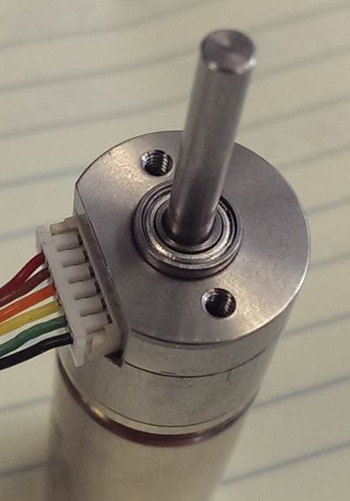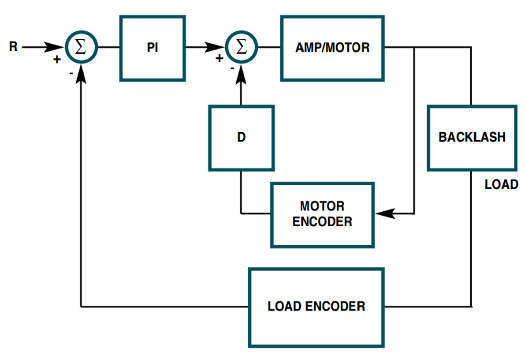 |
| February 14, 2017 | Volume 13 Issue 06 |
Designfax weekly eMagazine
Archives
Partners
Manufacturing Center
Product Spotlight
Modern Applications News
Metalworking Ideas For
Today's Job Shops
Tooling and Production
Strategies for large
metalworking plants
Gearheads and encoders: Simplifying positioning for OEMs
In a perfect motion system, the controller would send a signal and the hardware would deliver the load to the position commanded. In reality, error sources like backlash and mechanical hysteresis compromise performance. With enough time, effort, and money, those effects can be reduced, but motion is an enabling technology, not an end in itself.
OEMs want to focus on their product's unique value proposition, not on matching gear teeth and damping vibration. Now a pair of innovative components from MICROMO makes it easy to get the performance they need with minimal effort and cost. To remove error caused by vibration, compliance, and shock load, the gearhead encoder can be used to get the exact position and drive deviation to zero. With the choice of options, OEMs can develop innovative products of their own.

A new way of thinking!
Even the best gearheads have small gaps between the meshing teeth to allow them to interconnect without damage and to admit protective lubricants in between contacting surfaces. The downside is that this space introduces a small amount of lost motion known as backlash. This shows up as positioning error, especially in precision applications with frequent reversals. Even for high accuracy/precision gearheads, backlash still amounts to a few degrees of arc, and normal wear over the lifetime of the machine only worsens it. This is not a problem for a case packer or palletizer, but for applications like robotics, optical positioning, and gantries, even that small amount of error is too much.
Over the years, vendors have developed designs to mitigate backlash by using plastic spacers, split gears, and even springs to apply a preload that maintains contact between the gear teeth. None are ideal, though; they still feature a few arc minutes of error, and the preload needs to be adjusted for wear and environmental changes in order to preserve performance.
In a standard servo system, an encoder mounted to the motor shaft monitors the number of rotations to estimate the position of the load. Unfortunately, compliance, hysteresis, and backlash combine to introduce error between the predicted and actual load position. This can be as much as 2 to 3 deg. As we've already discussed, this doesn't necessarily cause a problem for standard applications. If you're trying to open up a gap between the performance of your system and that of the competition, however, it can be a problem. If you're trying to innovate, you need more.
To address the backlash, MICROMO offers the zero backlash gearhead (see Zero Backlash Gearheads). This unusual design offers, with some compromise, a product for low-torque, high-precision applications. These preloaded gearheads, however, result in a reduction of overall efficiency and load capability as well as a substantial increase in cost. But zero backlash does not mean zero positioning error. The hysteresis of the gearhead will still lead to a small positioning error on the output. So the exact position remains still unknown. To get information of the exact position of the output shaft of the gearhead, MICROMO developed two gearhead encoders.
Precise positioning in a small form factor
For starters, you need an encoder mounted to the output shaft of the gearhead, not the motor. This configuration enables the controller to measure the difference between predicted and actual location and compensate for the error. With an encoder on the motor shaft and the output shaft, the system can operate based on a dual control loop. It first closes the loop around the motor encoder and then around the gearhead encoder. This process takes a few milliseconds, but the result is highly accurate and precise. Standard gearheads can be used to achieve savings in cost, no reduction in efficiency and load capability, and the knowledge of the exact position. It can also be used as the only encoder in the system to drive the motor. The motor encoder is not needed anymore. Another use is an add-on to the existing zero backlash gearheads to obtain the exact position independent from hysteresis.
It's effective for ultra-demanding applications like micro robotics, 3D printing, and aerospace. Of course, these same applications present a more practical challenge-form factor. After all, adding an encoder to the gearhead won't do much good if the assembly won't fit in the space allotted. There's a third challenge that we've already discussed, which is the time spent fiddling with the motion control rather than on the innovative product being designed. Mounting an encoder to a gearhead shaft with all of the mechanical, electrical, and controls tasks involved takes time away from the primary design projects.

MICROMO developed a magnetic and an optical gearhead encoder. The magnetic encoder is based on the Hall effect and delivers a resolution up to 0.022 deg. The optical encoder reaches even a better resolution up to 0.014 deg with a far higher accuracy. Both encoders work well for applications involving vibration or shock loads.
Stainless steel housings make the gearhead encoders robust enough to handle the toughest contamination and vibration conditions an application can throw at them. Best of all, it's compact -- just 15 mm in diameter -- making it able to fit in the tightest of spots.
Application snapshots
- Micro robotic joints. When it comes to robot-guided surgery, even a millimeter of error can drastically impact patient outcome. Using the encoder gearhead in a robot end effector allows surgeons to position their equipment with absolute accuracy.
- 3D printers
- Industrial automation where size matters
- High-precision industry (optics)
- High-precision machining
- Pick and place
- Robotic surgery (with zero backlash gearhead)
The requirements for motion applications vary widely in terms of performance, budget, size, and more. In some cases, performance trumps all and the budget simply has to tolerate the result. In others, the application demands performance but within a reasonable cost. The gearhead encoders from MICROMO offer OEMs the opportunity to choose a solution that will enable them to deliver the most effective product possible.
Contact MICROMO Engineering to learn more about their high-precision, high-performance motion solutions and to help deliver your innovation to market first.
Source: MICROMO
Published February 2017
Rate this article
View our terms of use and privacy policy
